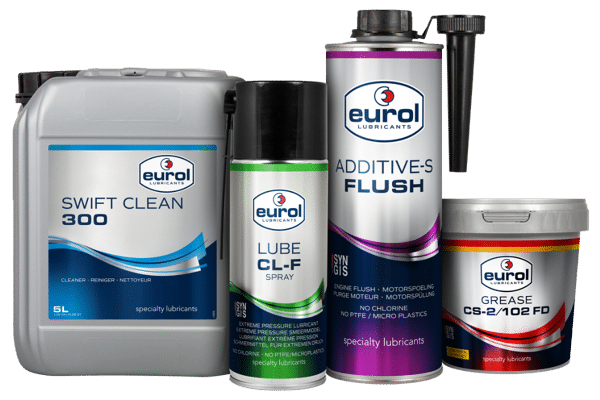
Visit Eurol during Automechanika Frankfurt
Visit Eurol during Automechanika in Frankfurt from September 10 to 14, 2024. Hall 12, stand E11.
23. Mai 2024

Im Laufe der Zeit können sich durch Oxidation, unvollständige Verbrennung und Verschleiß Verunreinigungen im Motor ansammeln. Diese Verunreinigungen sammeln sich in Form von Kohlenstoffablagerungen und lackartigen Rückständen an, die den Betrieb des Motors stören. Diese Ansammlungen führen zu mehreren Problemen:
Durch das Spülen des Motors bei einer Änderung der Motorkonstruktion wird ein erheblicher Teil der vorhandenen Verunreinigungen entfernt, wodurch das neue, sorgfältig abgestimmte Motoröl einen wesentlich saubereren Start erhält. Die Motorölspülung sorgt für eine gründliche Reinigung des Motors, indem sie hartnäckige Kohlenstoff- und Lackablagerungen löst, die sich im Laufe der Zeit angesammelt haben. Vergleichen Sie es mit dem Wechseln des Frittieröls in einer Fritteuse. Ohne Reinigung verbleiben Speisereste und altes, verunreinigtes Frittieröl in der Fritteuse. Wenn Sie direkt neues Frittieröl hinzufügen würden, wäre es im Vergleich zur ersten Reinigung der Fritteuse viel weniger sauber.
Es gibt Mechaniker, die Angst vor der Verwendung einer Motorölspülung haben. Dies kann daran liegen, dass die Kundenrechnung bei diesem Service etwas höher ausfällt. Diese Angst ist unbegründet, solange Sie Ihrem Kunden die Vorteile der Motorölspülung klar erläutern. Die Vorteile für Ihren Kunden liegen auf der Hand. Die Verwendung eines Motorölspüladditivs beim Ölwechsel verbessert die Motorleistung, reduziert den Kraftstoffverbrauch und die Emissionen und verlängert die Motorlebensdauer. Diese Mehrkosten amortisieren sich also sofort.
Ein weiteres häufiges Missverständnis ist, dass das Spülen zu lange dauert. Das ist nicht wahr. Der gesamte Spülvorgang dauert nur etwa 10 bis 20 Minuten. Diese Zeit lässt sich gut nutzen, um beispielsweise eine Auffangwanne und neues Motoröl zu besorgen oder den Arbeitsauftrag vorzubereiten. Bei Verwendung eines wirksamen Motorölspüladditivs wie Eurol Engine Flush ist der Einsatz einer speziellen Motorspülmaschine nicht erforderlich. Dadurch sparen Sie Zeit und Geld. Haben Sie schon ausgerechnet, welche zusätzlichen Einnahmen eine Motorspülung bei jedem Ölwechsel bringt? Dies ist ein zusätzlicher Vorteil, der die Rentabilität Ihrer Werkstatt steigert.
Außerdem ist es ein weit verbreiteter Irrglaube, dass die Motorölspülung nicht für ältere Motoren geeignet sei. Man geht davon aus, dass die Rückstände oder Lösungsmittel zu Schäden an Dichtungen oder Schläuchen führen könnten. Dies ist jedoch bei der Verwendung von Eurol Engine Flush nicht der Fall. Dieses Produkt wurde speziell entwickelt, um für alle Motortypen sicher zu sein, auch für ältere Motoren, da es keine aggressiven Lösungsmittel enthält, die die Dichtungen beschädigen können. Im Gegenteil: Es hilft, angesammelte Ablagerungen sicher zu entfernen und den Motor wieder in einen optimalen Zustand zu versetzen, ohne dass das Risiko einer Beschädigung besteht.
Der Spülvorgang ist einfach und erfolgt in 5 Schritten:
Wenn es um die Wahl eines zuverlässigen Motorölspüladditivs geht, ist Eurol Engine Flush die beste Option. Der Eurol Engine Flush wurde speziell entwickelt, um Ablagerungen und andere Verunreinigungen schnell und effektiv zu entfernen. Der Eurol Engine Flush kann mit allen Arten von Motorölen verwendet werden und ist sowohl für Benzin- als auch für Dieselmotoren geeignet. Dies liegt daran, dass dieses Additiv auf der Grundlage der gleichen Inhaltsstoffe wie das Motoröl selbst formuliert ist, der Schwerpunkt jedoch auf der Reinigung liegt. Dadurch wird der Schmierfilm nicht angegriffen, wie dies bei herkömmlichen Motorölspüladditiven auf Lösungsmittelbasis der Fall ist. Daher ist es auch kein Problem, wenn im neuen Motoröl Rückstände dieses Produkts zurückbleiben. Das Produkt beschädigt keine Dichtungen, Schläuche oder Dichtungen.

Visit Eurol during Automechanika in Frankfurt from September 10 to 14, 2024. Hall 12, stand E11.

Specific Eurol products are requested for different makes and types of cars. This raises both logistical and administrative issues, which requires managing all these produc...

Schmierstoff-Farbcodes sind ein integraler Bestandteil der Aufrechterhaltung eines sicheren und effizienten industriellen Arbeitsumfelds. Lesen Sie mehr in diesem Wissensar...

Unter dem Druck immer strengerer Abgasvorschriften in der Automobilindustrie sind leichte, hochdrehende Turbomotoren mit geringem Hubraum zum Standard geworden.

Visit Eurol during Automechanika in Frankfurt from September 10 to 14, 2024. Hall 12, stand E11.

Specific Eurol products are requested for different makes and types of cars. This raises both logistical and administrative issues, which requires managing all these produc...

Schmierstoff-Farbcodes sind ein integraler Bestandteil der Aufrechterhaltung eines sicheren und effizienten industriellen Arbeitsumfelds. Lesen Sie mehr in diesem Wissensar...

Unter dem Druck immer strengerer Abgasvorschriften in der Automobilindustrie sind leichte, hochdrehende Turbomotoren mit geringem Hubraum zum Standard geworden.
